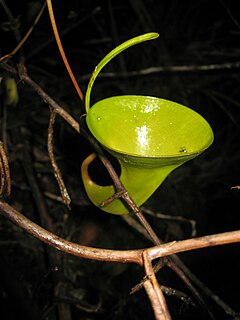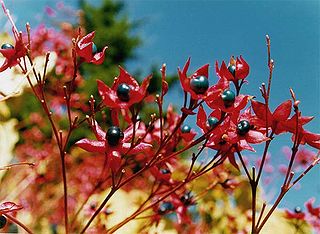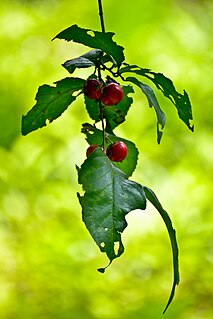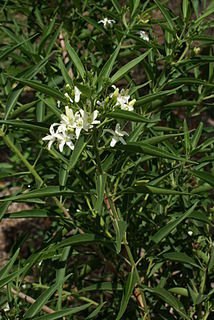
The Lamiaceae or Labiatae are a family of flowering plants commonly known as the mint or deadnettle or sage family. Many of the plants are aromatic in all parts and include widely used culinary herbs like basil, mentha, rosemary, sage, savory, marjoram, oregano, hyssop, thyme, lavender, and perilla, as well as other medicinal herbs such as catnip, salvia, bee balm, wild dagga, and oriental motherwort. Some species are shrubs, trees, or, rarely, vines. Many members of the family are widely cultivated, not only for their aromatic qualities, but also their ease of cultivation, since they are readily propagated by stem cuttings. Besides those grown for their edible leaves, some are grown for decorative foliage. Others are grown for seed, such as Salvia hispanica (chia), or for their edible tubers, such as Plectranthus edulis, Plectranthus esculentus, Plectranthus rotundifolius, and Stachys affinis. Many are also grown ornamentally, notably coleus, Plectranthus, and many Salvia species and hybrids.

Bromus is a large genus of grasses, classified in its own tribe Bromeae. They are commonly known as bromes, brome grasses, cheat grasses or chess grasses. Estimates in the scientific literature of the number of species have ranged from 100 to 400, but plant taxonomists currently recognize around 160–170 species.

Calamus is a genus of flowering plants in the palm family Arecaceae that are among several genera known as rattan palms. There are an estimated 400 species in this genus, all native to tropical and subtropical Asia, Africa, and Australia. They are dioecious, mostly leaf-climbing lianas with slender, reedy stems. To aid scrambling some species have evolved hooks on the underside of the midrib, or more commonly by modified "pinnae" or tendrils in the form of stout, backward-pointing spines. These stems may grow to lengths of 200 metres.

Lawsonia inermis, also known as hina, the henna tree, the mignonette tree, and the Egyptian privet, is a flowering plant and the sole species of the genus Lawsonia. It is the source of the dye henna used to dye skin, hair and fingernails, as well as fabrics including silk, wool and leather. Medicinal properties for the cure of renal lithiases, jaundice, wound healing; prevent skin inflammation. The bark is traditionally used in treatment of jaundice and enlargement of the spleen, renal calculus, leprosy and obstinate skin diseases. The species is named after the Scottish physician Isaac Lawson, a good friend of Linnaeus.

Andira inermis is a nitrogen-fixing tree native to the area from southern Mexico through Central America to northern South America ; it has been introduced to the Caribbean, the Antilles, Florida, and Africa. The tree has many names due to its wide distribution and multiple uses: it is also known as the cabbage bark, almendro macho, almendro de río or river almond (Honduras), bastard cabbage tree, cabbage angelin, cabbage bark, cabbage tree, carne asada, guacamayo (Honduras), Jamaica cabbage tree, harino (Panama), moca, partridge wood, worm bark, or yellow cabbage tree.

Nepenthes dubia is a tropical pitcher plant endemic to Sumatra, where it grows at an altitude of 1600–2700 m above sea level. The specific epithet dubia is the Latin word for "doubtful".

Nepenthes talangensis is a tropical pitcher plant endemic to Sumatra, where it grows in upper montane forest at elevations of 1800–2500 m above sea level.

Nepenthes inermis is a tropical pitcher plant endemic to Sumatra. The specific epithet inermis is Latin for "unarmed" and refers to the upper pitchers of this species, which are unique in that they completely lack a peristome.

Volkameria is a genus of flowering plants in the family Lamiaceae. It is pantropical in distribution. Many of the species are found in coastal habitats.

Nepenthes × pyriformis is a natural hybrid involving N. inermis and N. talangensis. It is known only from Mount Talang in Sumatra, to which N. talangensis is endemic. Nepenthes talangensis was only described as a distinct species in 1994. Prior to this it was placed within N. bongso and some of the older literature identifies this hybrid as N. bongso × N. inermis.

Clerodendrum is a genus of flowering plants formerly placed in the family Verbenaceae, but now considered to belong to the Lamiaceae (mint) family. Its common names include glorybower, bagflower and bleeding-heart. It is currently classified in the subfamily Ajugoideae, being one of several genera transferred from Verbenaceae to Lamiaceae in the 1990s, based on phylogenetic analysis of morphological and molecular data.

Nepenthes flava is a tropical pitcher plant endemic to northern Sumatra, where it grows in montane forest at 1800–2200 m above sea level.
2,3-Dihydroxybenzoic acid is a natural phenol found in Phyllanthus acidus and in the aquatic fern Salvinia molesta. It is also abundant in the fruits of Flacourtia inermis. It is a dihydroxybenzoic acid, a type of organic compound. The colorless solid occurs naturally, being formed via the shikimate pathway. It is incorporated into various siderophores, which are molecules that strongly complex iron ions for absorption into bacteria. 2,3-DHB consists of a catechol group, which upon deprotonation binds iron centers very strongly, and the carboxylic acid group by which the ring attaches to various scaffolds through amide bonds. A famous high affinity siderophore is enterochelin, which contains three dihydroxybenzoyl substituents linked to the depsipeptide of serine.

Ajugoideae is subfamily of the family Lamiaceae. The subfamily name of Teucrioideae is a synonym of Ajugoideae.
Aloe inermis is a small, stemless Aloe native to Yemen.

Lambertia inermis, Noongar chittick, is a shrub which is endemic to south-west Western Australia. It grows to 6 metres high and flowers from spring to winter. A more complete description is given in Florabase and Australian Flora online.

Bromus inermis is a species of the true grass family (Poaceae). This rhizomatous grass is native to Europe.

Flacourtia inermis, known commonly as lovi-lovi, or batoko plum, is a species of flowering plant native to the Philippines, but which has naturalized in tropical Asia and Africa.The common name of Flacourtia inermis in Indonesia, such as Tome-Tome, Lovi-lovi, lobi-lobi.

Clerodendrum heterophyllum is a species of flowering plant in the genus Clerodendrum of the family Lamiaceae. It is a native to Mauritius and La Réunion.
Lactuca inermis is a species of wild lettuce native to sub-Saharan Africa, Madagascar, and the Arabian peninsula. A pioneer species often found in disturbed areas, it is of variable height, from very short to quite tall and woody. Local people consume its young leaves, perhaps with a light boiling, as a salad green or vegetable.

















